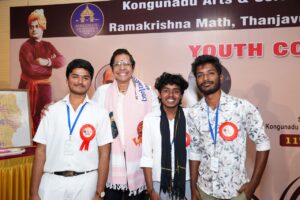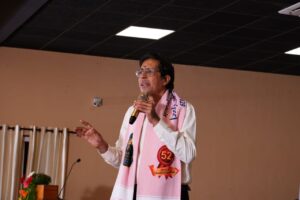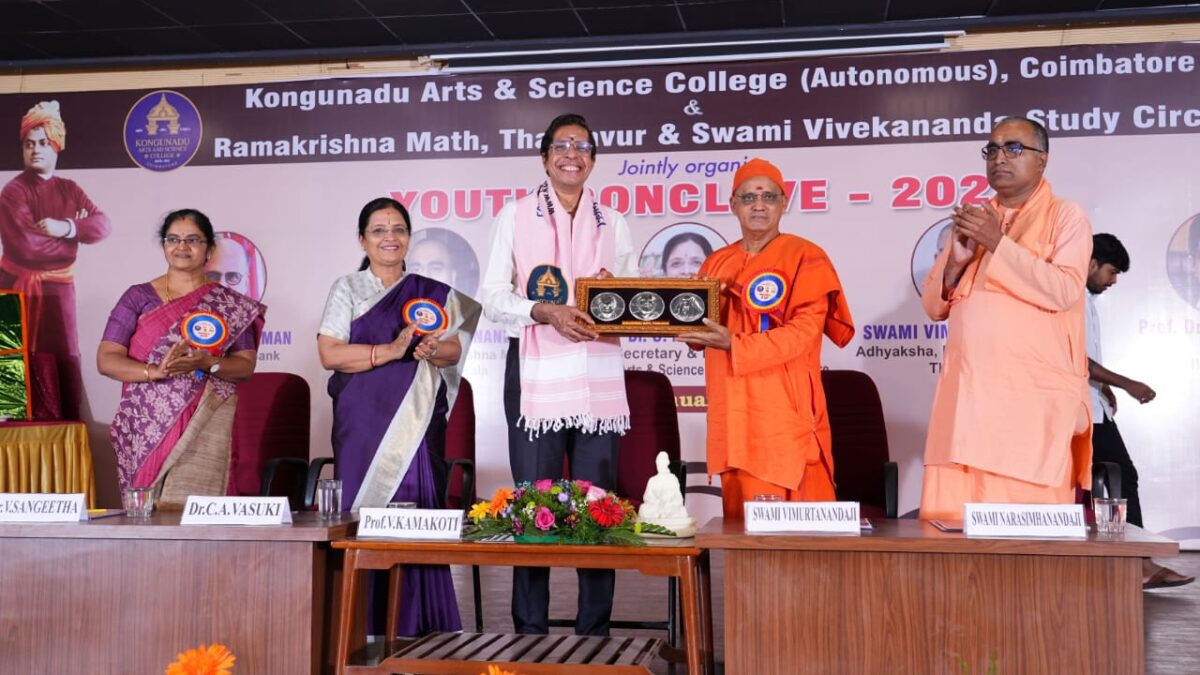Swami Vivekananda Study Circle of Kongunadu College of Arts and Science and Ramakrishna Math, Thanjavur jointly organised Youth Conclave on 11th January 2025.
Sangeetha, Principal of the College delivered the welcome address and CA Vasuki, the Secretary and Director of the college, gave the Presidential Address.
Swami Vimurtananda Maharaj, were honored, with a special gesture from Artist Ravivarma, a Computer Science student, who presented hand-drawn portraits of the guests.
The conclave featured four talks from great visionaries.


Swami Narasimhananda Maharaj from Ramakrishna Mission Sevashrama, Kozhikode, delivered the first talk, emphasizing self-confidence, ambition, and goal-setting as key to realizing one’s potential.
Seetharaman, former CEO of Doha Bank, Qatar, delivered the second talk, highlighting Vivekananda’s relevance in societal and personal transformations.
The third talk by Swami Vimurtananda Maharaj explored the practical applications of Vivekananda’s teachings.
The fourth talk by Kamakoti, Director, IIT Madras gave an insightful and inspiring session on the topic “Challenges in Attaining the Sustainable Development Goals (SDGs),” emphasizing the importance of collective efforts to achieve the 17 SDGs and create a better, more inclusive future for India as it approaches its centenary of independence in 2047.
He focused on key goals such as No Poverty, Zero Hunger, Good Health and Well-Being, Quality Education, Gender Equality, and Clean Water and Sanitation.
Highlighting the need for global responsibility, Kamakoti encouraged everyone to adopt the guiding principle, “Take the world’s responsibility on your shoulders and treat everyone the same.”
He further underscored the pivotal role of youth in driving change, urging students to address critical issues like poverty and illiteracy through a simple yet impactful approach: helping at least five underprivileged children by providing them with access to food and education.
By motivating these children to extend the same support to others, a ripple effect can be initiated, magnifying the positive impact.
For example, if 800 students each educate five children, this results in 4,000 educated individuals. If these 4,000 individuals follow suit, the number expands to 20,000, creating an exponential growth that can significantly reduce poverty and inequality.
Kamakoti shared real-life stories of global efforts to support polio-affected individuals, illustrating how such initiatives contribute to sustainability worldwide.
He also introduced the SAFE framework, providing a structured pathway for India’s progress: Sustainability to address long-term challenges; Aatma Nirbhar Bharat for building a self-reliant India through innovation and resilience; Futuristic Technology for leveraging advanced solutions to contemporary issues; and Entrepreneurship to foster creativity and drive development.
Concluding the session with a powerful call to action, Kamakoti inspired students to actively participate in India’s journey toward achieving the SDGs by 2047.
He emphasized that the collective efforts of today’s youth can lead to a brighter, more equitable, and sustainable future for both the nation and the world.
Another highlight of the event was the unveiling the students’ talent of a cubic art and string portrait of Swami Vivekananda done by the chief guests.
Swami Vivekananda’s portrait and a handbook were distributed to all the participant by Swami Vimridhananda Maharaj.
This event was a fitting tribute to Swami Vivekananda, fostering a sense of empowerment and commitment among the youth.
The event also featured students activities related to Swami Vivekananda.




